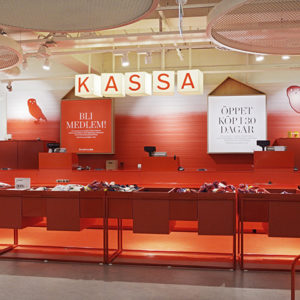

Shopping malls and department stores are beginning to shed their similarities to casinos, spaces so singularly driven by consumerism they’re often all but closed off to their environs. With Galleria Gwanggyo, the South Korean department store’s sixth branch, OMA not only created new vantage points from which to experience the city, but did so with a public loop that offers spaces for cultural exhibitions and performances. Chris van Duijn, OMA’s partner in charge of Galleria, explains more about how the project challenges traditional retail.
How did you design Galleria to accommodate different events?
CHRIS VAN DUIJN: As our main goal was to accommodate retail in a building that would serve a bigger purpose, all commercial areas are strategically framed by flexible spaces. Furthermore, we incorporated areas precisely designated for cultural events. The upper floors house cinemas, special club spaces and a cultural centre. On level 12, the Boulevard, there is a VIP and club lounge and the culture centre, which includes the Academy, a space that can host masterclasses, for instance, and video booths. At the top level, the rooftop garden functions as a viewing spot and a recreational and cultural zone.
But the most distinctive feature of Galleria is the public loop, whose role is far beyond a circulation space. Designed to bring people directly from the street into the upper levels, its route encircling the building accommodates several pop-up spaces, café areas and an auditorium-like staircase intended for smaller and informal events. It not only provides a shop-in-shop air but also enhances the social aspect of shopping.
Do you think it’s important for consumers to have a connection with the outdoors while shopping?
A conversation about the current state of retail inevitably brings us to how important context is. During our talks with Galleria about their ‘next level department store’ in South Korea, where traditional retail is still a successful model, we were at the same time working with long-lasting European department stores like KaDeWe, Galleries Lafayette and Selfridges on how to reinvent themselves. This shows that we are beyond the thesis that shopping is part of our daily social life and that this evolution is contextual. And, consequently, the architectural response to that is sensitive to the context as well.
For Galleria, establishing a relationship between the building and the outdoors resulted from an analysis of Gwanggyo and the goal we wanted to achieve there. As the city lacked a natural point of gravity, we wanted to anchor it, and to do so we could not produce a classical opaque cube-shaped department store. Our proposal had to factually relate to the surroundings, in order to become the new centre of the town and for residents to want to come and spend time there. That is the goal of the loop that travels along the façade, sometimes even exiting it. It’s a cantilevered transparent walkway from which to overlook Gwanggyo.
Whether the connection with the outdoors will become a vital feature in retail is not yet known, but stronger ties with urban context – as shopping becomes less standard and more bespoke – is inevitable. And, needless to say, sustainability will gain even more terrain.
Did you envision this building as a landmark that even non-consumers will visit? And how do you negotiate between tourism and commerce in such a place?
We’re always interested in the relation between public and private, in experiencing architecture through movement and in developing new typologies. Galleria was a perfect arena to combine these three factors. During our first site visit we were struck by Gwanggyo’s temporariness and flatness – the lack of a centre. Galleria could no longer be a traditional department store; it had to attract the residents of the town and provide them with a place where they would feel comfortable, where they could just hang out.
So the conversation is not so much about relating tourism and commerce, but rather about surrendering to the essential role that shopping has acquired in society and, more precisely, in the Asian context: an unarguable part of social life. That is why the design for Galleria challenges traditional retail. It brings natural light into the heart of a department store in an unprecedented way, highlighting the role of circulation routes, yet still provides space for classical boutique areas. Our design constantly encourages shops – and shoppers – to be in dialogue with the surroundings of the cube and the public areas inside of it.
Images courtesy of OMA
Photography by Hong Sung Jun






Add to collection










